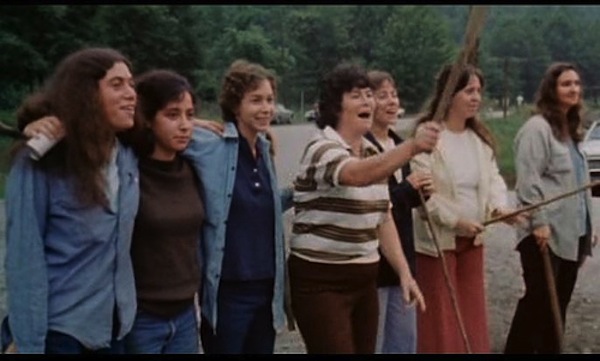Director: Barbara Kopple,
Watched on: DVD,
Rating: 5/5.
Harlan County USA, director Barbara Kopple’s account of a miner’s strikes in Harlan County, Kentucky in 1973, won the Oscar for Best Documentary in 1976. It remains a classic example of third person, observational, immersive documentary filmmaking. Kopple and her crew spent more than a year covering the coal miners’ strike against the Brookside Mine of the Eastover Mining Company when the company refused to negotiate a new contract with the recently unionized miners. What ensued wass an elemental stand-off between the hard-scrabble working men and women of the hollers of Appalachia and the gun-toting thugs of capitalist corporate America.
Harlan County USA is shot in grainy, 16mm color film, the textural equivalent here of raw earth and coal dust; the music is deep, backwoods bluegrass and miners’ laments; and the point-of-view is obviously one sympathetic to the miners’ cause. This was a time when documentary filmmaking was a tool of the rebels, the social historians, and the political anthropologists (while many of today’s docs look like hack work for well-funded non-profit causes).
Kopple includes brief but pungent historical perspectives on coal mining and the film is patient enough to let the atmosphere seep into her frames. The woodsmoke, the laundry on the line, the dented pick-ups and the plaid shirts, the music and the talk, echo back through generations. The progress of the strike is clearly followed and the film finds its characters in the conversations and conflicts between the strikers, the scabs, the cops, and the company mouthpieces. But what makes Harlan County USA especially exhilarating is the way in which the women of the county–the miners’ wives, daughters, and mothers–become the flag-bearers for the cause. The stakes are high, and they refuse to let their men cave in. They are fierce and articulate and certainly not the hicks the company lawyers wish they were. They wage a battle against obstacles of money and violence, but their roots in the land are too deep and their cause too passionate. It is to Kopple’s credit that her clear-eyed grasp of film journalism technique prevents her from romanticizing the miners or sentimentalizing their situation. Whatever nobility they have comes from within, it is not conferred on them by the filmmaker.
It’s refreshing to see a documentary that respects the craft-making side of the genre. In this age of digital equipment and home-based editing, subject matter often trumps technique. Most camerawork is solid but unremarkable. The editing is professional but too often serving the quirks and oddball characters of a story rather than paying attention to aesthetics. But in the hands of Kopple’s crew, we see a cinematic, formal approach: the film begins way down deep in the dungeon of the mine, with nothing but the miners’ helmet lamps illuminating the coal-black walls. The film follows the miners up from the shaft into the daylight to reveal their town, and then the rest of the townspeople; and gradually, organically, the story comes to light. The cinematography bends to the atmosphere, the sound and music are rich with detail.
Kopple has continued to make films in the last 35 years, but none have had the same empathy or impact as this one. That seems to be a reflection of the times. It’s increasingly difficult for a documentary like this one—that takes its time to learn a subject from the inside out—to get screen time in our theaters or to even find funders and distributors to pay attention.

